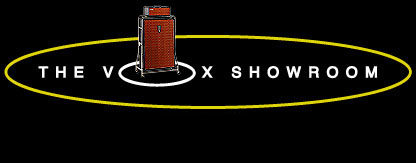2_Footer
|
© 1996 - 2024 The Vox Showroom, all rights reserved. No use on online auctions, eBay or Reverb.
|
 |
Introduced by Jennings Musical Industries in 1960, the Vox AC-10 was a ten watt, two channel amplifier with tremolo. It was designed by Vox lead engineer Dick Denney and documented |
on Jennings service schematic OS/008 No.3, first issued on September 9, 1960.
The chassis shown on this page was included in the 1 x 10" and 2 x 10" combo amplifier versions of the AC-10. Vox mounted the chassis to a wooden slider board as shown in the photo at right. The slider board facilitated ease in service by allowing the chassis to slide in and out of the cabinet like a drawer.
Vox also introduced an AC-10 head in 1963. The AC-10 head included both tremolo and reverb and used a different circuit and chassis than shown here.
|
 |
Normal Channel
The Normal channel used the triode section of a ECF82 tube for the preamp gain stage. The ECF82 was a dual element triode/pentode tube. The triode element of the ECF82 had a rather low amplification factor (mu) of 40. As a result, the AC-10 Normal channel lacked gain and drive, making the tone rather bland.
Vibrato Channel
The preamp for the AC-10 Vibrato channel used one of Dick Denney's favorite tubes, the EF86. Denney's preference for the harmonically rich EF86 tube was apparent as it was designed into the preamp circuitry of the entire original Vox amp line (AC-2, AC-4, AC-6, AC-10, AC-15 and AC-30). Tendencies toward microphony in larger amplifiers forced a redesign of the AC-30 in 1961 to eliminate the EF86, but it was retained in the AC-2 through the AC-15 until Vox discontinued the models.
"Grid Stopper" Resistors
A grid stopper resistor connects the signal coming from the input jacks to the grid of the first preamp tube. This resistor serves two functions. It helped to control parasitic oscillations (feedback) in the preamp stage. The resistor also acted as a low-pass filter to block high frequency radio transmissions from entering the preamp. Aside from the AC-10, Vox used 68k grid stopper resistors in all of their tube amps. Most Fender tube amps used 68k grid stoppers as well. A 68k grid stopper resistor established the low-pass filter frequency cut off point high enough to have little effect on the tone of the amplifier.
The AC-10 used 220k grid stopper resistors, more than three times the resistance of other Vox amplifiers. While this had little effect on gain, it had an effect on audio response. The treble response of an amplifier decreases as the value of the grid stopper resistor increases. Perhaps Vox was using this larger value grid stopper resistor value to trim the treble response of the AC-10.
Vibrato (or should I say, Tremolo)
Vox offered true pitch shifting vibrato on their AC-15 and AC-30 Twin amplifiers but vibrato "in name only" on the AC-10. Despite nomenclature on the control panel to the contrary, the AC-10 actually included tremolo, not vibrato.
The pentode section of the ECF82 tube was used as the modulator for the tremolo circuit. "Speed" and "Amplitude" (depth) controls adjusted the effect. A single button remote "egg pedal" actuated the tremolo.
Phase Inverter and Tone Control
An ECC83 tube, located in the circuit between the preamp and power amp circuits, served as the phase inverter or "phase splitter." The phase inverter split the audio signal coming out of the preamp into two signals that were 180 degrees out of phase with each other. Each of these signals fed one of the two EL84 power tubes using the classic "push-pull" output amplifier design.
The tone control was located within the phase inverter circuit. A .005 uf capacitor allowed only the treble frequencies from opposing sides of the phase inverter to reach the tone control. The tone control blended these "out of phase" treble frequencies together. When the "out of phase" treble signals were combined, they canceled each other out.
Power Amplifier
Like its bigger brother, the AC-15, the AC-10 power amplifier was powered by two EL84 power tubes in a Class A, cathode biased, no negative feedback amp circuit. A close comparison of the AC-10 schematic (OS/008) and AC15 schematic (OA/031) reveals that both models have vitually identical electronic components, voltages and circuitry in their power amps.
Power Supply
The AC-10 power transformer offered 115, 160, 205, 225 and 245 VAC taps on the primary along with 300 and 6.3 VAC taps on the secondary. A full wave EZ81 rectifier tube was combined with two 16 uf smoothing capacitors and an 8 henry choke to create the 305 VDC B+ power supply.
|





